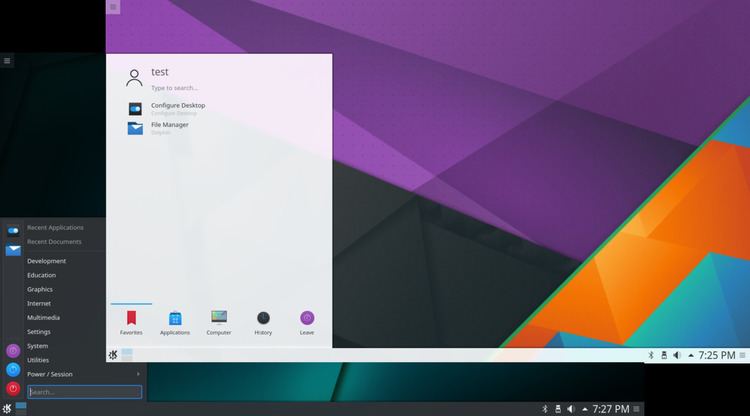Development status Active | ||
 | ||
Initial release 15 July 2014; 2 years ago (2014-07-15) Stable release 5.9.2 (14 February 2017; 18 days ago (2017-02-14)) [±] Preview release 5.8 Beta (15 September 2016; 5 months ago (2016-09-15)) [±] Repository anongit.kde.org/kdesrc-build | ||
KDE Plasma 5 is the fifth and current generation of the desktop environment created by KDE primarily for Linux systems. KDE Plasma 5 is the successor of KDE Plasma 4 and was initially released on 15 July 2014. It includes a new default theme, known as "Breeze", as well as increased convergence across different devices. The graphical interface was fully migrated to QML, which uses OpenGL for hardware acceleration resulting in better performance and reduced power consumption.
Contents
Software architecture
KDE Plasma 5 is built using Qt 5 and KDE Frameworks 5, predominantly plasma-framework.
Plasma 5.0 improves support for HiDPI displays and ships a converged graphical shell, able to modify the graphical shell according to the device in use. It also includes a new default theme, dubbed Breeze. Changes under the hood include the migration to a new, fully hardware-accelerated graphics stack centered on an OpenGL(ES)-based scene graph (canvas). Plasma 5 completes the migration of KDE Plasma 4 to QtQuick. Qt 5's QtQuick 2 uses a hardware-accelerated OpenGL(ES) scenegraph to compose and render graphics on the screen, which allows for the offloading of computationally expensive graphics rendering tasks onto the GPU, which frees up resources on the system's main CPU, and is faster and more power efficient.
Windowing systems
KDE Plasma 5 uses the X Window System, but support for Wayland is under development. Initial support for Wayland was made available in the 5.4 release. Stable support for a basic Wayland session was provided in the 5.5 release (December 2015).
Development
Since the split of the KDE Software Compilation into KDE Frameworks 5, KDE Plasma 5 and KDE Applications, each subproject can develop at its own pace. KDE Plasma 5 is on its own release schedule, with feature releases every three months, and bugfix releases in the intervening months.
Plasma Mobile
Plasma Mobile is a Plasma variant for smartphones.
After Plasma Active sponsor Coherent Theory (under the Make·Play·Live brand) had to give up their ambitions to release a tablet computer, Blue Systems emerged as new sponsor and shifted the focus of Plasma's handheld work towards smartphones.
The official announcement of the new formfactor interface was on 25 July 2015 at Akademy, accompanied by a working prototype running on a Nexus 5. Plasma Mobile runs on Wayland and it is compatible with Ubuntu Touch applications and eventually Android applications via KDE's Shashlik project – also sponsored by Blue Systems.
A build based on Kubuntu is available for the Nexus 5.
History
The first Technology Preview of Plasma 5 (then tentatively called Plasma 2) was released on 13 December 2013. On 15 July 2014 the first release version – Plasma 5.0 – saw the light of day. In spring 2015, Plasma 5 replaced Plasma 4 in many popular distributions, such as Fedora 22, Kubuntu 15.04, and openSUSE Tumbleweed.
Releases
Feature releases are released every four months (up to 5.8 every three months) and bugfix releases in the intervening months.
